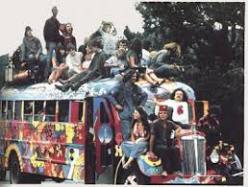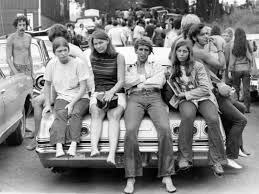
Janis Joplin
Janis Joplin – Ball And Chain (Amazing Performance at Monterey)
With Big Brother and the Holding Company, she performed the song at the Monterey Pop Festival in 1967 to an enthusiastic audience and critical reception. The first performance on June 17 was not filmed, so the band was persuaded to perform the song again on the next day. This shorter version
http://youtu.be/Bld_-7gzJ-o
Janis Joplin – Piece Of My Heart
http://youtu.be/7uG2gYE5KOs

Singer (1943–1970)
Bio
Synopsis
Wild Child
Early Musical Interests
Back in Texas, Joplin took a break from her music and her hard-partying lifestyle, and dressed conservatively, putting her long, often messy hair into a bun and doing everything else she could to appear straight-laced. But the conventional life was not for her, and her desire to pursue her musical dreams wouldn’t remain submerged for long.
Joplin slowly returned to performing, and in May 1966, was recruited by friend Travis Rivers to audition for a new psychedelic rock band based in San Francisco, Big Brother and the Holding Company. At the time, the group was managed by another longtime friend of Joplin’s, Chet Helms. Big Brother, whose members included James Gurley, Dave Getz, Peter Albin and Sam Andrew, was part of the burgeoning San Francisco music scene of the late 1960s; among the other bands involved in this scene were the Grateful Dead.Big Brother

Solo Career
Joplin struggled with her decision to leave Big Brother, as her bandmates had been like a family to her, but she eventually decided to part ways with the group. She played with Big Brother for the last time in December 1968.
Following a historic performance at Woodstock (August 1969), Joplin released her first solo effort, I Got Dem Ol’ Kozmic Blues Again Mama!, in September 1969, with Kozmic Blues Band. Some of the project’s most memorable songs were “Try (Just a Little Bit Harder)” and “To Love Somebody,” a cover of a Bee Gees tune. But Kozmic Blues received mixed reviews, with some media outlets criticizing Joplin personally. Feeling uniquely pressured to prove herself as a female solo artist in a male-dominated industry, the criticism caused distress for Joplin. “That was a pretty heavy time for me,” she later said in an interview with Howard Smith of The Village Voice. “It was really important, you know, whether people were going to accept me or not.” (Joplin’s interview with Smith was her last; it took place on September 30, 1970, just four days before her death.) Outside of music, Joplin appeared to be struggling with alcohol and drugs, including an addiction to heroin.
Joplin’s next album would be her most successful, but, tragically, also her last. She recorded Pearl with the Full Tilt Boogie Band and wrote two of its songs, the powerful, rocking “Move Over” and “Mercedes Benz,” a gospel-styled send-up of consumerism.Tragic Death and Legacy
Tony Winner Will Play Janis Joplin in Upcoming Biopic
Nina Arianda set to portray the singer, with Sean Durkin directing
BY ROLLING STONE
An upcoming Janis Joplin biopic has found its star: Tony award-winning actress Nina Arianda will appear as the singer in the Sean Durkin-directed Joplin, Deadline reports.
According to producer Peter Newman, who’s been trying to put together a Joplin flick along with his partners for the past 12 years, Arianda will sing all of Joplin’s music. That’s no easy task, especially trying to capture Joplin’s signature grit, but Newman says he’s confident in his star’s talents.
“I’ve never in my life seen an actress walk on a stage and convey the duality of vulnerability with overheated sexuality, which is what Janis was all about,” Newman told Deadline.
While this isn’t Arianda’s first foray into film – she’s held supporting roles in Midnight -n Paris, Tower Heist and others – it will be her first major starring role. The actress won acclaim and a Tony for best actress in a play for her turn in the Broadway show Venus in Fur. Meanwhile, director Durkin broke out last year with his film Martha Marcy May Marlene, which garnered plenty of praise at festivals and landed him the Best Director honor at Sundance.
Joplin will focus on the last six months of the Texas-born musician’s career, though it will also include flashbacks to her early career. The film has exclusive rights to use 21 of Joplin’s best known tracks.
While there have been other attempts to produce a Joplin biopic, especially as Newman’s sat on the back-burner, the producer had scored Joplin’s crucial song and life rights as well as the arrangements by backing band Big Brother and the Holding Company. Newman also holds the rights to the collection of letters Love, Janis and Piece of My Heart, the book written by Rolling Stone reporter David Dalton, who traveled with Joplin during the six months before the heroin overdose that killed her in 1970.
Read more: http://www.rollingstone.com/music/news/tony-winner-will-play-janis-joplin-in-upcoming-biopic-20120710#ixzz3K6cF1LwT
Follow us: @rollingstone on Twitter | RollingStone on Facebook
Nina Arianda set to portray the singer, with Sean Durkin directing

An upcoming Janis Joplin biopic has found its star: Tony award-winning actress Nina Arianda will appear as the singer in the Sean Durkin-directed Joplin, Deadline reports.
According to producer Peter Newman, who’s been trying to put together a Joplin flick along with his partners for the past 12 years, Arianda will sing all of Joplin’s music. That’s no easy task, especially trying to capture Joplin’s signature grit, but Newman says he’s confident in his star’s talents.
“I’ve never in my life seen an actress walk on a stage and convey the duality of vulnerability with overheated sexuality, which is what Janis was all about,” Newman told Deadline.
While this isn’t Arianda’s first foray into film – she’s held supporting roles in Midnight -n Paris, Tower Heist and others – it will be her first major starring role. The actress won acclaim and a Tony for best actress in a play for her turn in the Broadway show Venus in Fur. Meanwhile, director Durkin broke out last year with his film Martha Marcy May Marlene, which garnered plenty of praise at festivals and landed him the Best Director honor at Sundance.
Joplin will focus on the last six months of the Texas-born musician’s career, though it will also include flashbacks to her early career. The film has exclusive rights to use 21 of Joplin’s best known tracks.
While there have been other attempts to produce a Joplin biopic, especially as Newman’s sat on the back-burner, the producer had scored Joplin’s crucial song and life rights as well as the arrangements by backing band Big Brother and the Holding Company. Newman also holds the rights to the collection of letters Love, Janis and Piece of My Heart, the book written by Rolling Stone reporter David Dalton, who traveled with Joplin during the six months before the heroin overdose that killed her in 1970.
Read more: http://www.rollingstone.com/music/news/tony-winner-will-play-janis-joplin-in-upcoming-biopic-20120710#ixzz3K6cF1LwT
Follow us: @rollingstone on Twitter | RollingStone on Facebook



































